The Orce archaeological site is providing evidence of human occupation in Europe over 1.2 million years ago. Now part of the Geoparque Granada project
By Nick Nutter | Updated 19 Mar 2022 | Granada | History |
Login to add to YOUR Favourites or Read Later
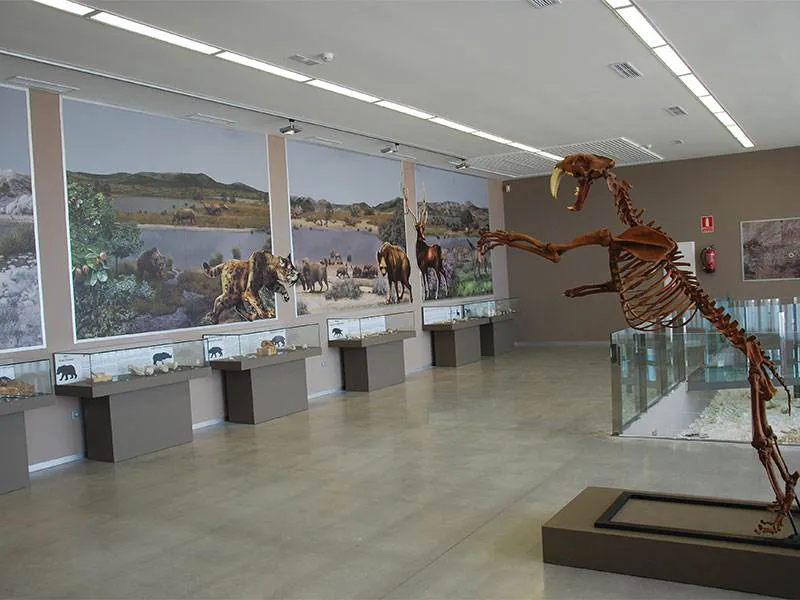
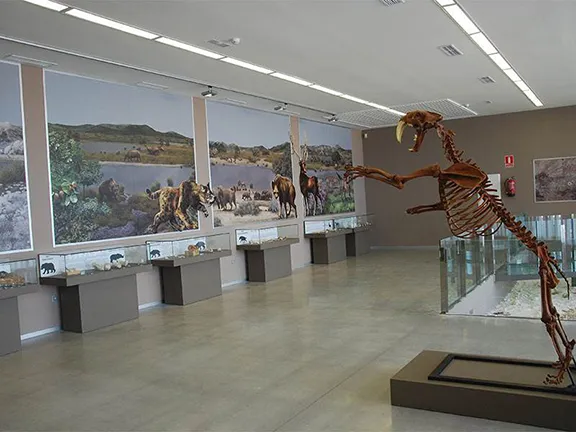
Orce Museum of Prehistory
Orce is a small village with a population of about 1,400 in Granada Province in the Municipality of Huescar. It is roughly 150 kilometres north east of Granada, almost on the border with Almeria, at an altitude of 926 metres. In winter the temperature can fall to 0C and in summer is usually in the high 30s or 40s. A small amount of rain falls in spring and the rest is scattered through the year. Traditionally the local economy centres on livestock, particularly the segureña lamb, renowned for its succulence and flavour, and agriculture. The land is dry, dusty and deeply riven by dry gullies between ancient cliffs that, millions of years ago, formed the shores of a large lake. Orce, today, is situated on the edge of Europe’s only semi arid zone. 1.4 mya the landscape was very different. It was one of green and lush pastures. The first hominids to arrive in Europe settled there and left evidence of their passing, the oldest evidence to date of humans in Europe.
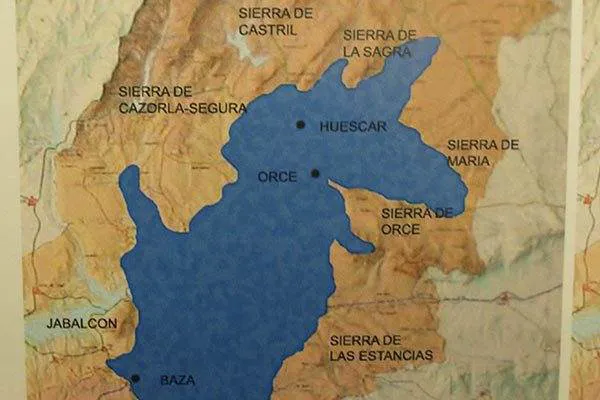
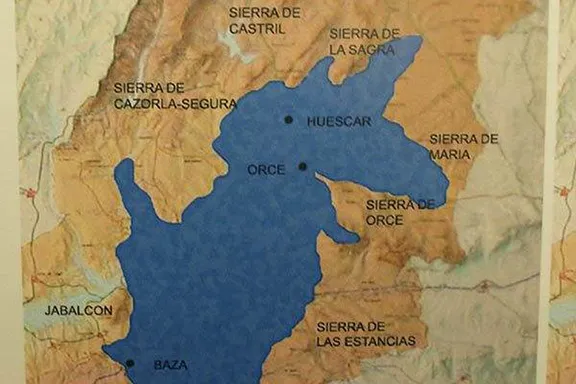
Paleo Lake Baza
For the moment though Orce is a typical high, dry plains village in Andalucia. It has a castle, the Alcazaba de las Siete Torres, the Castle of Seven Towers, that was started in the 6th Century AD and finished in the 16th. Clustered round the castle is the village itself with a square and a few bars and restaurants that feature the famous segureña lamb on the menus. Nearby is El Cerro de la Virgen, the hill of the virgin, the site of a Bronze Age settlement.
On the outskirts of Orce are the archaeological sites of Barranco Leon, Venta Micena and Fuentenueva 3 and it is these sites that will finally put Orce on the map. Many of the invaluable finds from these sites are displayed, with excellent explanations in Spanish only, in a new interpretation centre dedicated to the archaeological sites. The Museum of Prehistory (Museo de Prehistoria) is on the northern edge of the town.
In the summer of 1982, three palaeontologists from the Institut de Paleontologia de Sabadell in Catalonia, Josep Gilbert, Jordi Agusti and Salvador Moyà-Solà, working at the Venta Micena site, discovered a fragment of skull. In July 1983, it was announced at a press conference that the fragment was human and 1.4 million years old, making it, at that time, the oldest proof of humans in Europe. Unfortunately, a large proportion of the scientific community did not agree, arguing that the skull fragment was equine. The resulting argument was fierce and vicious and ultimately did nothing for Josep Gilbert’s reputation. Since then two teeth, identified as hominid milk teeth, have been found at Barranco León. They have been dated to between 1.04 and 1.73 million years old. Some palaeontologists argue that at least one of the teeth is from an extinct species of hippopotamus.
To start the true story of Orce we have to go back a couple of million years.
Over many thousands of years the climate in any one area has changed many times, it is a complicated combination of the influence of monsoons, oceanic currents, the oscillation of the earth in its orbit, the position on earth of the maximum amount of sunlight and heat at any one time that has caused this climatic change in the past. On occasion a catastrophic event has had a more immediate affect on a climatic system. More recently, during the last few thousand years, human activity has also had an impact.
Complicated or not, the effects of changing climate affects the vegetation. As previously arid lands become wetter and sometimes cooler, sometimes warmer, so grasses, shrubs and eventually trees, colonise that land. Conversely as the weather becomes dryer and warmer or dryer and cooler, so the trees give way to shrubs, then grasses and finally desert. This all happens in oscillating waves, think of the waxing and waning of the moon except over hundreds of thousands of years.
As the leading edges of the vegetation belts expand so to do the animals that prefer that particular environment. Following those animals, herbivores, come the hunters and scavengers, the big cats, hyenas and humans. None are aware of this dispersal, they are simply staying, over many generations, within their own comfort zone. As those green comfort zones expand and contract, so too do the animal denizens of that zone. The idea of a tribe of humans trekking out of an arid zone into some sort of garden of Eden is totally wrong. So too in many cases is the image of the climate changing for the worse and the animals, including humans, simply lying down and dying, becoming extinct. Sure there are instances where the green comfort zones forced the inhabitants to retreat over many generations and occupy some sort of cul de sac from which there was no escape, the case of the Neanderthals in Gibraltar is one such instance, but in many more instances the zones retreated and its occupants merged with the occupants of other zones.
It has been shown that these early hominid dispersals originated in Africa. As climate changed the green zones expanded north and east into the Middle East and from there into southern Europe, spreading into northern Europe and into Asia as far as China. Populations of animals moved with those zones and dispersed and spread into Europe and Asia. Individual groups of species became separated during this long journey and each started to evolve in their own way. Eventually the climate would change in such a way that the Middle East and north Africa again became impassable arid zones leaving populations of animals and humans roaming around Europe and Asia, each still within their green comfort zone. On some occasions the comfort zones lasted longer in Asia than Europe as ice came down from the north, forcing the green zones to move south. On occasion long separated species would meet again.
Lately it is this notion of fluid movement, separation, re-meeting and moving again that has caused archaeologists to rethink the concept of species and re-evaluate findings from DNA analysis. An altogether more complicated picture of evolution, particularly of humans, is emerging.
One of the factors that makes humans unique in the animal kingdom is that they learnt to adapt to an ever broadening range of climates and utilise the resources associated with that ever increasing range. They learnt to live in diverse green comfort zones as opposed to just one.
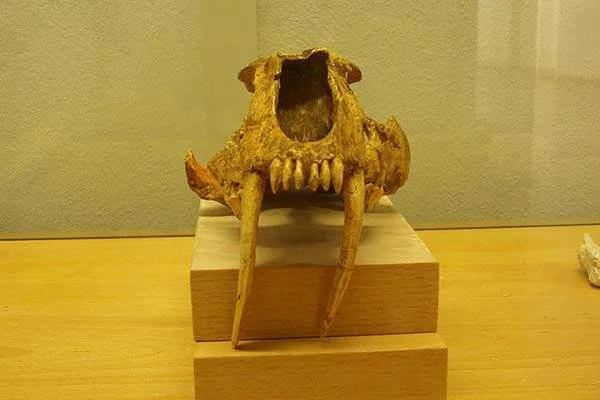
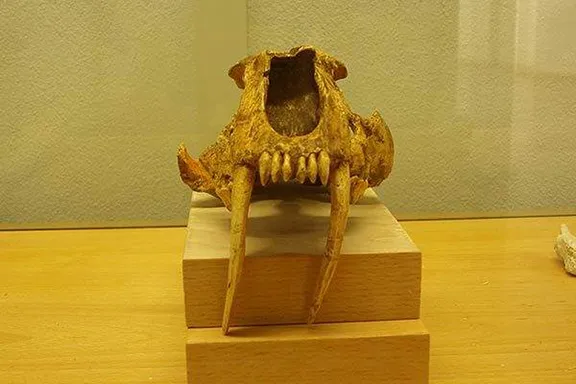
Sabre Toothed Cat
Back to Orce. Between 2 million and 1.5 million years ago, megafauna from Africa arrived in the area along with suitably sized predators and scavengers. They had all taken advantage of a climate change to disperse through the Middle East. Following them came hominids.
The landscape they saw was very different to that of today. The climate was much wetter and probably a little cooler than present day. The depression at Orce was a large lake, Lake Baza, surrounded by reeds and lush vegetation.
Archaeologists have taken pollen samples from various dated layers of strata to determine what the vegetation was like 1.5 million years ago. The predominant vegetation was not dissimilar to the Mediterranean flora we see today, cyprus, oak, wild olive and pine trees. In addition there were plants that required more water and they would be in the gullies and ravines, birch, hazel, holly, ash and privet. You can still see that mix of vegetation in the nearby Sierra de Cazorla. On the margins of the lake there were willows and elms. There were also some trees not seen today in this part of Spain, cedar and red fir. Beneath the trees the herbaceous plants consisted of mugwort, plantain, thistles, flowering plants of the crucifera family and various grasses.
Grazing on these plants the archaeologists have found fossilised bones from many herbivores. At least five species of deer lived in the woodland and grasslands, one an extinct giant named Megaceroides solilhacus that stood over 2 metres tall at the shoulder, a species with huge antlers sometimes known as the Irish Elk – Megaloceros, a smaller deer native to Eurasia – Cervus, the other a smaller also extinct deer, Pseudodama sp, weighing 50 – 90 kilos.
Closer to the lake in the scrub and shallows would be found the megafauna.
An extinct mammoth (Mammuthus meridionalis) that stood 4 metres tall at the shoulder, one of the largest proboscideans ever to live, native to Europe and Asia – Mammuthus meridionalis, an extinct European Hippopotamus – Hippopotamus antiquus, rhineoceros – Stephanorhinus etruscus, a one toed horse – Equus altidens, and a number of large grazers such as the wild ox Bovini bos. In the woods were also a number of species of bear – Ursus sp and a crested porcupine – Hystrix major
This rich hunting ground naturally attracted the predators such as a sabre toothed cat – Megantereon whitei and large scavengers, the giant hyenna.
Smaller mammals spread throughout the landscape were hedgehogs, shrews, water rats, mice, voles and rabbits. Reptiles and amphibians were also abundant. Just the list of frogs and toads reveals a diverse ecological landscape. The Iberian painted frog toad, spadefoot toad, common parsley frog, common toad, natterjack toad and common frog all lived in the lake margins. Reptiles included the Iberian skink and a number of snakes.
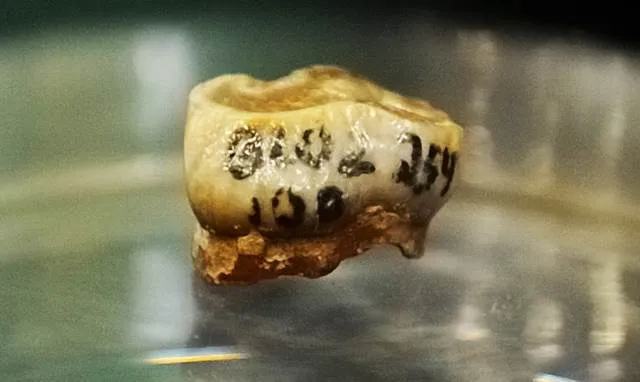
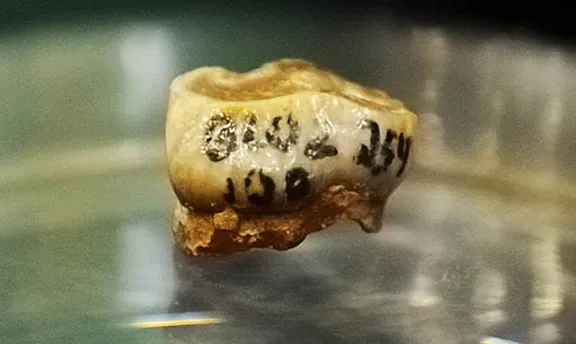
The disputed molar from Orce
A rich scavenging ground indeed for the early humans that occupied this area. Evidence of humans comes in two forms. Evidence of human activity and fossilised pieces of human bone. Two pieces of the human anatomy were originally found at Orce, an upper molar tooth and a piece of skull. The latter is still unconfirmed, some say it is part of an equine skull, although the Orce team seem fairly adamant. Obtaining the age of artefacts in this case was done by taking samples from the strata in which the finds were made and using a technique called electron spin resonance and secondly observing the paleomagnatism of the strata. ESR gave a result of between 1.02 and 1.73 million years old and paleomagnetism between 1.07 and 1.77 million years old. Between those years the magnetic poles were reversed which can be seen in the polarity of certain minerals in rocks as they form. Statistically, we are due for another change any day.
Biochronologic evidence further indicates a date close to 1.4 million years ago.
Evidence of human activity came from two sources, manufactured stone tools of a style known as Oldowan, and fossilised animal bones showing striation marks made by stone tools. Again samples of strata from just above and just below the artefacts were subjected to ESR. The results were in the same range as those for the tooth.
Further circumstantial evidence is provided by the biozone, the macro and micro faunal and flora which is what would be expected in the area at the time.
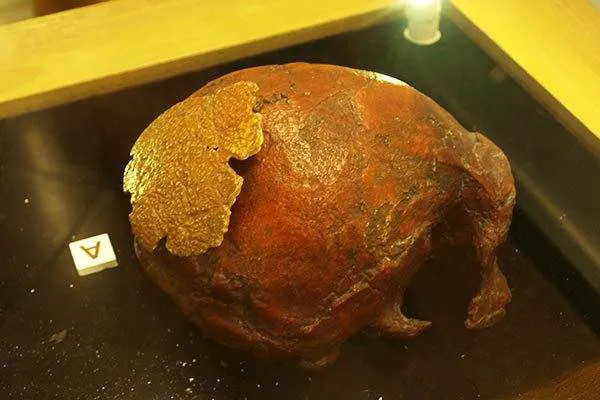
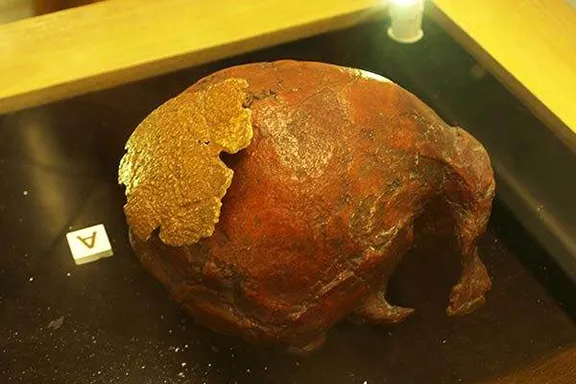
Disputed skull fragment
By 1.9 million years ago Homo erectus was firmly established in East Africa. Due to climatic changes discussed above, a window of opportunity, a green comfort zone, expanded from the south and east into central Africa and finally into the northeast and into the Middle East where they merged with similar green zones expanding from the east through Iraq and Iran and from the north and west from Europe. Early forms of Homo erectus, or later forms of Homo habilis, were the first hominids to disperse out of Africa in this way. Whether they had developed a food gathering strategy that involved actively following animals who themselves dispersed, or whether populations increased forcing those on the outer edges of ‘civilisation’ to break off and find new territory, thus moving a short distance every generation, is not known, but disperse they did.
If we accept that a green zone opened soon after Homo erectus appears on the archaeological horizon in East Africa, then he was very quick to reach Mojokerto in Java and Dmanisi in Georgia. Finds at both sites show that a hominid reached those places by 1.8 mya. By 1.6 mya he was at Sangiran in Java. Meanwhile, back in Europe hominids arrived at Orce about 1.4 mya and further north at Atapuerca by 1.25 mya. Finds made in Britain, that was connected to the continent then, indicate that hominids arrived at Happisburgh by 840,000 years ago or even as early as 950,000 years ago.
Once the early Homo erectus had left Africa there were effectively three groups evolving independently. One group dispersed through Asia, one group dispersed through Europe and one group remained in Africa. To differentiate between the African and Asian group, some archaeologists have called the European group Homo antecessor, a separate species, and the African group Homo ergaster, yet another species. My view, supported by much analysis, is that all three species are one and that the Asian and European variants are just that, geographical varieties of a single species. They all share the same common ancestry so are in the same clade.
A clade is different to a grade of evolution and here it becomes interesting. All analyses have shown that Homo erectus represents a different grade of evolution than their more ancient African predecessors, his immediate ancestor, Homo habilis and the Paranthropus group and the Australopithecus group. A grade is an evolutionary grouping of organisms showing a similar adaptive pattern. Increase in body size and robustness, changes in limb proportions, and greater encephalization all indicate that these hominids were more like modern humans in their adaptive pattern than their African ancestors were. The hominids discussed in this article are not only members of a new and distinct grade of human evolution; they are also closely related to each other. Whether they all belong to the same clade is still debatable. Nevertheless, a major adaptive shift had taken place—one setting hominid evolution in a distinctly more human direction.
So what did these early Homo erectus that arrived on the shores of Lake Baza look like? All three groups of early erectus, African, Asian and European, shared some common characteristics that then evolved in slightly different directions within each group. The features common to an evolutionary well developed Homo erectus are described below.
As conclusively shown by the discovery of the nearly complete skeleton of “Nariokotome Boy” (from Nariokotome, on the west side of Lake Turkana in Kenya), we know that Homo erectus was larger than earlier hominids. From this and other less-complete specimens, anthropologists estimate that some Homo erectus adults weighed well over 100 pounds, with an average adult height of about 5 feet 6 inches. Another point to keep in mind is that Homo erectus was quite sexually dimorphic—at least as indicated by the East African specimens. For adult males, weight and height in some individuals may have been considerably greater than 100 pounds. In fact, if the Nariokotome Boy had lived to adulthood, he probably would have grown to an adult height of over 6 feet (Walker, 1993). Increased height and weight in Homo erectus are also associated with a dramatic increase in robusticity. In fact, a heavily built body was to dominate hominid evolution not just during Homo erectus times, but through the long transitional era of pre-modern forms as well. Only with the appearance of anatomically modern Homo sapiens did a more gracile skeletal structure emerge, and it still characterizes most modern populations.
While Homo erectus differs in several respects from both early Homo and Homo sapiens, the most obvious feature is its cranial size—which is closely related to brain size. Early Homo had cranial capacities ranging from as small as 500 cm3 to as large as 800 cm3. Homo erectus, on the other hand, shows considerable brain enlargement, with a cranial capacity of about 700 (even smaller cranial capacities have been found recently from the Caucasus region of Europe) to 1,250 cm3 (and a mean of approximately 900 cm3). However, in making such comparisons, we must bear in mind two key questions: What is the comparative sample, and what were the overall body sizes of the species being compared? To put these figures into perspective, the range of cranial capacities for a modern Homo sapien is 975 cm3 to 1500 cm3.
As for the first question, many anthropologists are now convinced that more than one species of early Homo existed in East Africa around 2 mya. If so, only one of them could have been the ancestor of Homo erectus . If we choose the smaller bodied sample of early Homo as our presumed ancestral group, Homo habilis, then Homo erectus shows as much as a 40 percent increase in average cranial capacity. But if the comparative sample we use is the larger-bodied group of early Homo for example, skull 1470, from East Turkana, considered by many to be Homo rudolphensis then Homo erectus shows a 25 percent increase in cranial capacity. The waters here are muddy, it seems that four separate species co-existed in the Lake Turkana basin between 2 and 1.5 mya, Homo habilis, Homo erectus, Homo rudolphensis and Paranthropus boisei. The Paranthropus group split off from the mainstream Homo evolutionary path about the same time as the Australopithecus group did, about 5 million years ago.
Brain size is closely linked to overall body size. We’ve focused on the increase in Homo erectus brain size, but Homo erectus was also considerably larger overall than earlier members of the genus Homo. In fact, when we compare Homo erectus with the larger-bodied early Homo sample, their relative brain size is about the same (Walker, 1991).
What’s more, when we compare the relative brain size of Homo erectus with that of Homo sapiens,we see that Homo erectus was considerably less encephalized than later members of the genus Homo.
Homo erectus crania display a highly distinctive shape, partly because of increased brain size, but probably more correlated with increased body size. The ramifications of this heavily built cranium are reflected in thick cranial bone, large browridges above the eyes, and a projecting nuchal torus, a thickened bony prominence extending transversely across the back of the head. The braincase is long and low, receding from the large browridges with little forehead development. Also, the cranium is wider at the base compared with earlier and later species of genus Homo. The maximum cranial breadth is below the ear opening, giving the cranium a pentagonal shape (when viewed from behind). In contrast, the skulls of early Homo and Homo sapiens have more vertical sides, and the maximum width is above the ear openings.
Most specimens also have a sagittal ridge (also called a sagittal keel) running along the midline of the skull. Very different from a sagittal crest, the keel is a small ridge that runs front to back along the sagittal suture. The sagittal keel, along with the browridges and the nuchal torus, don’t seem to have served an obvious function in the life of Homo erectus but most likely reflect bone buttressing in a very robust skull.
The evolutionary path taken by the Asian group and the stay at home African group is beyond the scope of this article. We must concentrate on the European part of the clade.
The oldest Homo erectus finds have been made at Dmanisi in Georgia and they date to about 1.8mya. Not only is this a very early date they also look different to the ‘standard’ Homo erectus described above which may indicate they are either a very early Homo erectus or the remains of an earlier dispersal.
In some respects, the Dmanisi crania are similar to those of the standard Homo erectus for example, a long, low braincase, wide base, and sagittal keeling. However other characteristics of the Dmanisi individuals are different to other hominid finds outside of Africa. In particular, the most complete specimen has a less-robust and thinner browridge, a projecting lower face, and a relatively large upper canine. At least when viewed from the front, this skull is more reminiscent of the smaller early Homo specimens from East Africa, Homo habilis, than it is of Homo erectus. Also, this individual’s cranial capacity is very small—estimated at only 600 cm3, well within the range of early Homo. In fact, the four Dmanisi crania so far described in the literature have relatively small cranial capacities—the other three were estimated at 630 cm3, 650 cm3, and 775 cm3.
The newest evidence from Dmanisi includes several postcranial bones, coming from at least four individuals (Lordkipanidze et al., 2007). This new evidence is especially important because it allows us to make comparisons with what is known of Homo erectus from other areas. The Dmanisi fossils have an unusual combination of traits. These hominins were not especially tall, with an estimated height ranging from about 4 feet 9 inches to 5 feet 5 inches. Certainly, based on this evidence, they seem much smaller than the standard Homo erectus from East Africa or from Asia. Yet, although very short in stature, they still show body proportions such as leg length like that of Homo erectus (and Homo sapiens) and quite different from that seen in earlier hominids.
Which leaves us with a problem as you will soon realize. Let us look first at the Atapuerca discoveries. Just one specimen has been found, a partial jaw with a few teeth. Provisional analysis shows that it is closer to the Dmanisi fossils than the standard Homo erectus. As with Dmanisi the tools found associated with the fossil were Oldowan and there are cut marks on animal bones found in the same strata. These finds have been dated to 1.25 mya.
At Orce 1,244 stone artefacts have been discovered along with animal bones displaying striation marks associated with just one human tooth, until the partial skull bone is confirmed human it is probably wisest to ignore it. These finds have been dated to 1.4 mya making them the oldest proof of human activity in western Europe. The tooth naturally, has been subject to intense scrutiny, analysis and examination. Features of the tooth were found that are displayed in those of the genus Homo and Australopithecus but not in Paranthropus. Other features are found in Paranthropos and also in early Homo as well as Homo heidelbergensis.
Whoever they were the hominids that lived on the shores of Lake Baza scavenged for their meat rather than hunted. Their diet consisted primarily of seeds, nuts and tuberous roots. No evidence of the use of fire has yet been found. Their toolkit took the simplest form, the Oldowan. Flakes of rock were struck off a core. The results were used as multi purpose tools rather than trying for one design to perform one job.
So who were they, were they early Homo erectus or late Homo habilis or even Australopithecus? The jury is still out.
Baruzzi, Miquel. (2013). Hominids, doubts and big headlines: The Orce Man controversy in the Spanish press (1983-2007). Dynamis. 33. 365-387+275.
Dean, M & Smith, B. (2009). Growth and Development of the Nariokotome Youth, KNM-WT 15000. 10.1007/978-1-4020-9980-9_10.
Demenocal, Peter & Stringer, Christopher. (2016). Human migration: Climate and the peopling of the world. Nature. 538. 10.1038/nature19471.
Ferring, Reid & Oms, Oriol & Agustí, Jordi & Berna, Francesco & Nioradze, Medea & Shelia, Teona & Tappen, Martha & Vekua, Abesalom & Zhvania, David & Lordkipanidze, David. (2011). Earliest human occupations at Dmanisi (Georgian Caucasus) dated to 1.85–1.78 Ma. Proceedings of the National Academy of Sciences of the United States of America. 108. 10432-6. 10.1073/pnas.1106638108.
Gibert, J. & Gibert Beotas, Luis & Albadalejo, S. & Ribot, Francesc & Sánchez, Florentina & Gibert, P.. (1999). Molar tooth fragment BL5-0: The oldest human remain found in the Plio-Pleistocene of Orce (Granada province, Spain). Human Evolution. 14. 3-19. 10.1007/BF02436193.
Gibert, J. & Sánchez, Florentina & Ribot, Francesc & Gibert Beotas, Luis & Ferràndez-Cañadell, Carles & Iglesias, A. & Gibert, P. & Gonzalez, F.. (2002). Human remains in the Lower Pleistocene sediments from the Orce and Cueva Victoria areas (South Eastern Spain). L'Anthropologie. 106.
Groucutt, Huw & Petraglia, Michael & Bailey, Geoffrey & Scerri, Eleanor & Parton, Ash & clark-balzan, Laine & Jennings, Richard & Lewis, Laura & Blinkhorn, James & Drake, Nick & Breeze, Paul & Inglis, Robyn & Es, Maud & Meredith-Williams, Matthew & Boivin, Nicole & Thomas, Mark & Scally, Aylwyn. (2015). Rethinking the Dispersal of Homo sapiens out of Africa. Evolutionary Anthropology. 24. 10.1002/evan.21455.
Lordkipanidze, David & Vekua, Abesalom & Rightmire, Philip & Margvelashvili, Ann. (2007). Hominid Fossils from Dmanisi and Their Place Among the Early Hominids. EAM. 175.
Martínez-Navarro, Bienvenido & Turq, Alain & Ballester, Jorge & Oms, Oriol. (1997). Fuente Nueva-3 (Orce, Granada, Spain) and the first human occupation of Europe. Journal of human evolution. 33. 611-20. 10.1006/jhev.1997.0158.
Mchenry, Henry. (2005). How big were early hominids?. Evolutionary Anthropology: Issues, News, and Reviews. 1. 15 - 20. 10.1002/evan.1360010106.
Mirazon Lahr, Marta & Foley, Robert. (2005). Multiple dispersals and modern human origins. Evolutionary Anthropology: Issues, News, and Reviews. 3. 48 - 60. 10.1002/evan.1360030206.
Ribot, Francesc & Gibert Beotas, Luis & Ferràndez-Cañadell, Carles & Olivares, Enrique & Sánchez, Florentina & Leria, Maria. (2015). Two Deciduous Human Molars from the Early Pleistocene Deposits of Barranco León (Orce, Spain). Current Anthropology. 56. 134-142. 10.1086/679615.
Toro-Moyano, Isidro & Turq, Alain & Martínez-Navarro, Bienvenido & Oms, Oriol & Agustí, Jordi. (2000). Los yacimientos del Pleistoceno inferior de Barranco León y Fuente Nueva 3 de Orce (Granada). Contribución al conocimiento del primer poblamiento humano de Europa. SPAL: Revista de prehistoria y arqueología de la Universidad de Sevilla, ISSN 1133-4525, Nº 9, 2000, pags. 179-188. 10.12795/spal.2000.i9.09.
Rito, Teresa & Richards, Martin & Fernandes, Verónica & Alshamali, Farida & Cerny, Viktor & Pereira, Luisa & Soares, Pedro. (2013). The First Modern Human Dispersals across Africa. PloS one. 8. e80031. 10.1371/journal.pone.0080031.
Toro-Moyano, Isidro & Martínez-Navarro, Bienvenido & Agustí, Jordi & Souday, Caroline & Castro, José & Martinón-Torres, María & Fajardo, Beatriz & Duval, Mathieu & Falguères, Christophe & Oms, Oriol & Parés, Josep & Anadón, Pere & Julià Brugués, Ramon & Jose Manuel, García-Aguilar & Moigne, Anne-Marie & Espigares, M. & Ros-Montoya, Sergio & Palmqvist, Paul. (2013). The oldest human fossil in Europe, from Orce (Spain). Journal of Human Evolution. 65. 1-9. 10.1016/j.jhevol.2013.01.012.
Sites to Visit
Museum of Orce Prehistory and Palaeontology
To read the full pdf with all images and maps click here